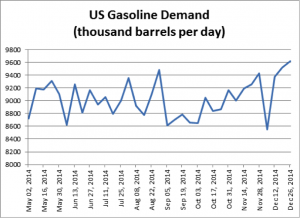Oil prices dip as blizzard strikes the Northeast
OPEC’s secretary-general, Abdullah al-Badri, said Monday that the great oil price-drop could be over, and that it could start to climb again soon.
“Now the prices are around $45-$50, and I think maybe they reached the bottom and will see some rebound very soon,” he told Reuters in London.
Al-Badri also warned that oil might spike to $200.
That may well occur in the future. But for now, the floor hasn’t been reached. Prices rallied briefly after al-Badri’s comments, but they settled down in Monday’s trading session. Brent, the international benchmark, fell 1.3 percent to $48.16. U.S., or West Texas Intermediate, fell 1 percent to $45.15, but narrowed after the restart of a refinery in Whiting, Indiana.
Some experts had anticipated movement in the markets following the death of Saudi King Abdullah last week. But his successor, half-brother Salman, pledged “continuity in energy and foreign policies on Friday and was quick to retain veteran oil minister Ali al-Naimi, sending a message aimed at calming a jittery oil market,” Reuters reported.
The massive blizzard in the Northeast affected crude prices: The anticipated storm caused prices of heating oil to rise, but jet fuel dropped, in anticipation of canceled flights.
As Reuters reported:
The blizzard will result in canceled flights, less driving and increased use of heating oil, creating mixed indicators for crude oil, Matt Smith, an analyst at Schneider Electric, said.
“We saw this with Hurricane Sandy,” Smith said.


